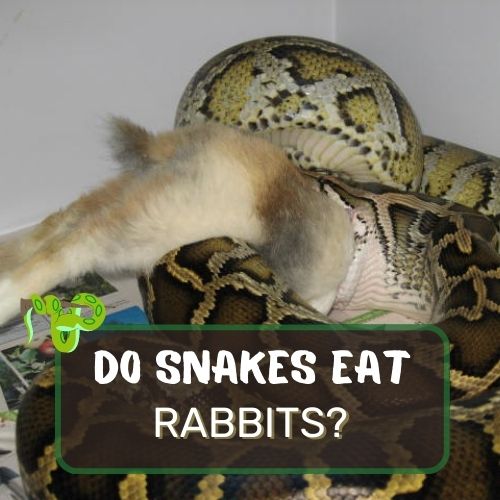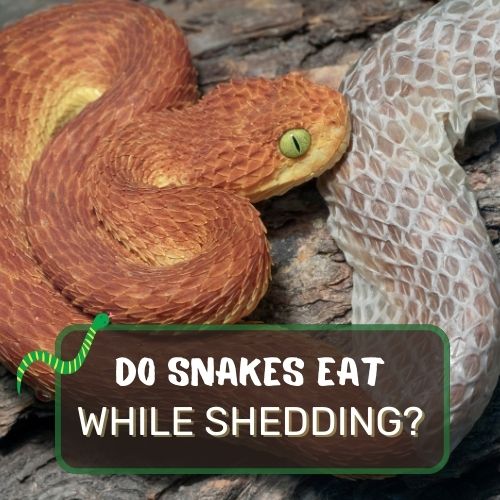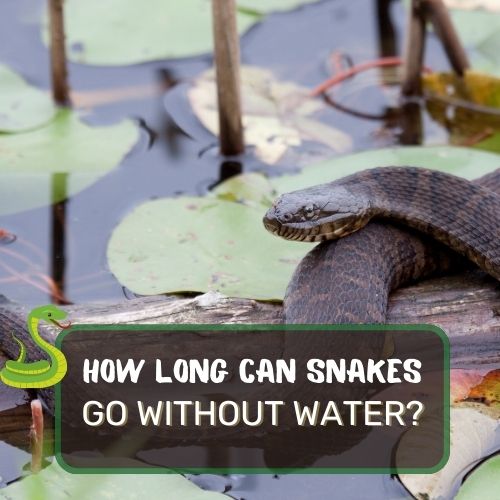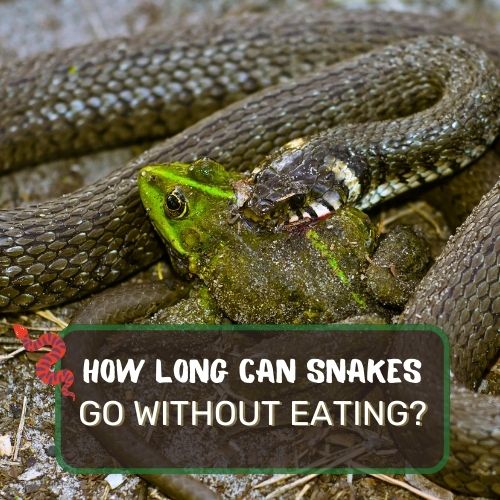
In this article, we delve into the intriguing world of snakes and their dietary habits, focusing specifically on the question: “Do snakes eat rabbits?”
We explore the factors that determine a snake’s diet, examining the types of snakes that are known to consume rabbits and the reasons behind this behavior.
By reading this article, you will gain valuable insights into the ecological significance of such interactions, the adaptations that facilitate these predatory behaviors, and the role of rabbits in the snake’s food chain.
Whether you are a curious nature enthusiast or seeking to understand the predator-prey dynamics in the animal kingdom, this article will provide you with a comprehensive understanding of the captivating relationship between snakes and rabbits.
Table of Contents
Do Snakes Eat Rabbits? (Yes, They Do)
Yes, snakes do eat rabbits, but it’s primarily the larger species of snakes that can consume such sizable prey. The most notable snake that preys on rabbits is the Burmese python (Python bivittatus). Native to Southeast Asia and invasive in places like Florida, the Burmese python can grow to impressive lengths, allowing it to consume larger animals, including rabbits. In their natural habitat, these pythons might encounter and eat wild relatives of the rabbit. Similarly, rattlesnakes and other large constrictors in various parts of the world might also prey on young rabbits or hares. However, smaller snake species would find rabbits too large to consume.
Snakes as Obligate Carnivores
When it comes to dietary preferences, snakes are fascinating creatures. These slithering reptiles fall into the category of obligate carnivores, meaning they exclusively consume meat to meet their nutritional needs.
Unlike some other animals that have more diverse diets, snakes have evolved to thrive on a diet solely comprised of prey animals.
Snakes Can Eat Any Meat, Including Rabbits
Among the various delicacies that snakes find irresistible, rabbits are undoubtedly on the menu. These flexible predators have a remarkable ability to consume a wide range of meat, and rabbits are no exception.
The question, “do snakes eat rabbits,” leads us to explore the fascinating world of snake predation and their dietary habits.
Larger Snakes Can Easily Swallow Adult Rabbits
It’s essential to note that the answer to our question is not a simple yes or no. The size and species of the snake play a significant role in determining its prey.
While smaller snakes might prefer smaller meals like insects or mice, larger snakes have been known to take on more substantial challenges, even devouring adult rabbits!
Reasons Why Snakes Eat Rabbits

Natural Prey for Snakes
In the wild, snakes have established a delicate balance with their environment. As skilled hunters, they have adapted to feed on creatures that are abundant and readily available within their habitat.
For many snake species, rabbits happen to be a natural prey choice due to their prevalence in various ecosystems.
Nutritional Value of Rabbits for Snakes
From a nutritional standpoint, rabbits provide a substantial feast for snakes.
These furry creatures are rich in proteins, fats, and other essential nutrients, making them a highly valuable meal for these reptilian carnivores.
Devouring a rabbit can sustain a snake for an extended period, allowing them to thrive in their environment.
Adaptations of Snakes for Hunting and Consuming Rabbits
Snakes have evolved unique adaptations that make them proficient hunters of rabbits and similar prey.
Their specialized senses, such as heat-sensing pits and forked tongues, help them detect and track potential meals.
Once they’ve honed in on their target, their incredible ability to swallow prey whole, thanks to their flexible jaws and lack of a sternum, allows them to tackle animals larger than their head!
With these incredible adaptations, snakes have mastered the art of hunting and consuming rabbits, showcasing their remarkable survival instincts in the wild.
Snake Species That Eat Rabbits

Large Snakes Like Boas and Pythons
Among the various snake species, the larger ones, such as boas and pythons, stand out as formidable predators capable of consuming rabbits.
With their robust bodies and incredible strength, these snakes have earned a reputation as some of the most impressive hunters in the animal kingdom.
Their size and power allow them to take on larger prey, making rabbits a suitable meal for them.
Specific Snake Species Known to Eat Rabbits
Let’s delve into some specific snake species that have a known appetite for rabbits:
1. African Rock Python
The African Rock Python is a massive snake native to sub-Saharan Africa. Known for its impressive size, it can reach lengths of up to 20 feet or more.
As opportunistic hunters, they prey on a wide range of animals, and adult rabbits can become a part of their diet. Using their stealth and strength, African Rock Pythons strike and constrict their prey before swallowing it whole.
2. Burmese Python
Native to Southeast Asia, the Burmese Python is one of the largest snake species in the world. These snakes have become established in various parts of the United States as an invasive species.
Their powerful bodies allow them to overpower and consume rabbits with ease, making them a potential threat to local wildlife in regions where they are not native.
3. Reticulated Python
Another giant among snakes, the Reticulated Python, inhabits the forests and grasslands of Southeast Asia.
With their exceptional length and keen sense of smell, they can detect potential prey from a considerable distance. Rabbits are one of the many animals that fall within the menu of this impressive serpent.
4. Boa Constrictor
Boa Constrictors are found in diverse habitats across North, Central, and South America. They are non-venomous snakes that rely on constriction to subdue their prey.
These snakes are powerful constrictors, and while they generally target smaller animals, they have been known to feast on rabbits as well.
Snakes’ Hunting and Feeding Behavior

Ambush Hunting Techniques of Snakes
Snakes are master ambush predators. They employ a range of stealthy tactics to surprise and capture their prey.
Some species, like the African Rock Python, lie in wait near known animal trails, camouflaging themselves perfectly with their surroundings.
When an unsuspecting rabbit ventures too close, the snake strikes with remarkable speed, coiling around its prey to prevent escape.
Swallowing Whole vs. Constriction
After a successful hunt, snakes employ two primary methods to devour their catch: swallowing whole or constriction. The larger constrictors, like the Burmese Python and Boa Constrictor, use constriction to suffocate their prey before ingestion.
They wrap their muscular bodies around the animal and tighten their grip with each breath the prey takes until it cannot breathe anymore.
On the other hand, snakes with more flexible jaws, such as pythons, can swallow their prey whole.
By dislocating their jaws and stretching their skin, they create a passage wide enough to engulf animals much larger than their head. This process might take some time, but it allows them to consume prey in one piece.
Digestion Process of Snakes
After swallowing their meal, the real challenge for snakes begins – digestion. Snake digestion is an intricate process that can take days or even weeks, depending on the size of the prey.
The snake’s powerful stomach acids and enzymes break down the prey’s tissues, turning them into a liquid that the snake’s body can absorb for nourishment.
During the digestion period, snakes become temporarily vulnerable, and they often find secluded spots to avoid potential threats.
Once digestion is complete, the snake is ready to resume its activities, fully nourished and prepared for the next hunt.
Predation Impact on Rabbit Populations

Natural Predator-Prey Relationship
The predation of rabbits by snakes is a natural part of the delicate balance in ecosystems. In the wild, predator-prey relationships are essential for maintaining ecological harmony.
While snakes are efficient hunters of rabbits, they also serve as a population control mechanism for these small herbivores.
This relationship prevents rabbit populations from becoming too large and overwhelming their available resources.
Ecological Role of Snakes in Controlling Rabbit Populations
Snakes play a vital ecological role in controlling rabbit populations. By preying on rabbits, they help prevent overgrazing in certain habitats, ensuring that vegetation remains balanced and healthy.
This, in turn, benefits other animals and plant species that share the same environment. Additionally, by keeping rabbit numbers in check, snakes indirectly contribute to the survival of their prey’s food sources, maintaining a stable ecosystem.
Factors Influencing Predation Rates
Several factors can influence the predation rates of snakes on rabbits. The abundance of both snakes and rabbits in a particular area plays a crucial role.
For instance, in regions with higher snake populations, rabbits might face more significant predation pressure. Conversely, an increase in rabbit numbers might attract more snakes to the area, creating a natural balance.
The availability of alternative prey can also impact predation rates. When other food sources are scarce, snakes might turn to rabbits more frequently.
Furthermore, environmental factors, such as changes in weather and habitat, can influence the hunting behavior and success rates of both snakes and rabbits.
Protecting Rabbits from Snakes

Prevention Measures for Rabbit Owners
Rabbit owners who keep these furry companions as pets can take specific precautions to protect them from potential snake encounters:
1. Secure Enclosures
When housing rabbits outdoors, it’s crucial to provide them with secure enclosures. These enclosures should have sturdy walls and a roof to prevent snakes from entering and posing a threat to the rabbits.
2. Natural Deterrents
Using natural snake deterrents in and around the rabbit’s living space can help reduce the likelihood of snake visits. Certain plants, such as marigolds and garlic, are known to repel snakes and can be strategically placed to create a protective barrier.
3. Creating Snake-Proof Barriers
For rabbit owners in snake-prone areas, building snake-proof barriers around the enclosure can be highly effective. Installing hardware cloth or mesh with small gaps can prevent snakes from slithering their way in.
Outdoor Precautions for Wild Rabbits

Wild rabbits face natural predation risks, including encounters with snakes. While it’s essential to allow nature to take its course, there are some precautions that can be taken to increase their chances of survival:
1. Habitat Modification
Providing rabbits with diverse habitats can offer them natural hiding places and escape routes from predators like snakes. Dense vegetation, burrows, and rocky crevices can serve as safe havens.
2. Predator-Proof Shelters
Building predator-proof shelters in areas where wild rabbits frequent can offer protection. These shelters can be made from materials like rocks and logs, providing safe spaces for rabbits to seek refuge.
3. Monitoring and Relocation Strategies
Regular monitoring of rabbit populations can help detect potential predation risks. In some cases, when rabbit populations are at risk, relocation to safer areas can be considered to ensure their survival.
By taking these precautions, both pet owners and conservationists can contribute to safeguarding rabbits from snake predation while still respecting the natural dynamics of the ecosystem.
Snake and Rabbit Coexistence
Balance Between Predator and Prey in Ecosystems
The coexistence of snakes and rabbits exemplifies the delicate balance that exists in ecosystems. As predators and prey, they have evolved alongside each other, shaping their behaviors and characteristics in response to one another.
This natural relationship plays a crucial role in maintaining the health and stability of the environment.
Importance of Maintaining Biodiversity
The coexistence of snakes and rabbits is just one example of the intricate web of life in ecosystems. Biodiversity is essential for the resilience and sustainability of our planet.
Each species has its unique role to play, and the loss of one can have cascading effects on others. Preserving the diversity of life, including snakes and rabbits, is vital for the overall health and functioning of ecosystems.
Conservation Efforts for Both Snake and Rabbit Species
Conservation efforts are crucial for ensuring the continued coexistence of snakes and rabbits. Protecting the habitats of these species, implementing sustainable land-use practices, and raising awareness about their ecological importance are essential steps in their conservation.
Conservation initiatives can also focus on addressing threats to snake populations, such as habitat destruction and poaching, as well as protecting rabbit populations from excessive predation and other anthropogenic pressures.
By working to preserve both species, we can contribute to a more balanced and harmonious natural world.
Misconceptions and Myths About Snakes and Rabbits
Exaggerated Fears and Stereotypes
Throughout history, snakes have been the subject of myths, fears, and stereotypes. They are often portrayed as dangerous and malevolent creatures, leading to unnecessary fear and hostility towards them.
Similarly, rabbits have been associated with ideas of overpopulation and being pests in certain contexts, leading to misunderstandings about their role in ecosystems.
Promote Understanding and Appreciation for Both Species
Promoting understanding and appreciation for both snakes and rabbits is crucial for their conservation and coexistence.
Education about their ecological importance, natural behaviors, and the role they play in maintaining the balance of nature can help dispel fears and stereotypes.
Encouraging responsible behavior in areas where snakes and rabbits are present is also essential. This includes avoiding unnecessary harm to snakes, respecting their habitats, and providing safe spaces for both snakes and rabbits to thrive.
By fostering a positive perspective and appreciation for these creatures, we can cultivate a greater sense of harmony with the natural world and work towards a future where snakes and rabbits can coexist peacefully alongside other wildlife.
FAQ
Why Do Snakes Eat Bunnies?
Snakes eat bunnies, along with other small animals, as part of their natural diet. As obligate carnivores, snakes have evolved to rely on meat to fulfill their nutritional requirements. The ability to consume a variety of prey, including rabbits, is essential for their survival in the wild.
Do Bull Snakes Eat Bunnies?
Yes, bull snakes, also known as gopher snakes, are opportunistic predators that eat a diverse range of prey, including bunnies. These non-venomous snakes are excellent hunters and play a vital role in controlling rodent populations, making them beneficial for farmers and ecosystems.
Do Rabbits Keep Snakes Away?
There is a common belief that rabbits can keep snakes away due to their strong scent. However, this is largely a misconception. While rabbits might have a unique odor, it is not a significant deterrent for snakes. Snakes primarily rely on their specialized senses and hunting instincts rather than being repelled by the scent of potential prey.
Conclusion
Throughout this article, we have explored the fascinating relationship between snakes and rabbits, shedding light on their coexistence in diverse ecosystems.
Snakes, as obligate carnivores, have the natural instinct to consume meat, and rabbits often find themselves on the menu due to their prevalence and nutritional value. This interaction is an integral part of the delicate balance that sustains ecological harmony.
It is crucial to recognize the importance of maintaining biodiversity and understanding the ecological roles that both snakes and rabbits play.
Snakes are not to be feared but respected for their contribution to controlling prey populations, while rabbits are more than just prolific breeders but essential members of the ecosystem.
To ensure the coexistence of these species and their conservation, we must dispel myths and misconceptions that perpetuate unnecessary fear or hostility.
Instead, let us embrace a deeper understanding and appreciation for the natural world, fostering an environment where snakes and rabbits can thrive alongside other wildlife.
By promoting responsible behavior, protecting their habitats, and engaging in conservation efforts, we can contribute to a future where snakes and rabbits continue to play their crucial roles in the intricate tapestry of life.
Let us strive for a harmonious coexistence that preserves the diversity and beauty of our planet for generations to come.




0 Comments